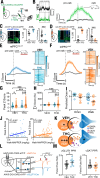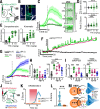This is a preprint.
Behavioral Decoding Reveals Cortical Endocannabinoid Potentiation during Δ9-THC Impairment
- PMID: 41040173
- PMCID: PMC12485844
- DOI: 10.1101/2025.09.26.678874
Behavioral Decoding Reveals Cortical Endocannabinoid Potentiation during Δ9-THC Impairment
Abstract
How Δ9-tetrahydrocannabinol (THC) impairs natural behaviors in mice remains unknown. We developed a video-monitored behavioral platform with machine learning classifiers to unravel discrete changes in natural mouse behaviors. THC infusion into the medial prefrontal cortex (mPFC) disrupted walking kinematic features characteristic of impairment responses. THC predominantly increased mPFC GABAergic activity preceding walk initiation shifting the mPFC excitatory/inhibitory (E/I) balance. Pose-defined closed loop photo-stimulation of mPFC GABAergic neurons demonstrated that THC exacerbates selected parameters of motor impairment. Surprisingly, THC also induced a time locked, movement-induced, transient potentiation of mPFC endocannabinoid (eCB) release and ensuing CB1R-mediated synaptic inhibition. Here we establish that THC-modifies mPFC E/I balance to excitation via dynamic changes in eCB release which acts to induce behavioral impairment.
Conflict of interest statement
Competing interests: Anthony English is the founder and CEO of BioSyft Inc., a company developing technologies for behavioral analysis in preclinical research. Michael Bruchas, Nephi Stella, and Benjamin Land are scientific advisors in BioSyft Inc. The other authors declare no competing interests.
Figures





References
-
- Van Den Elsen G. A., Tobben L., Ahmed A. I., Verkes R. J., Kramers C., Marijnissen R. M., et al. Effects of tetrahydrocannabinol on balance and gait in patients with dementia: A randomised controlled crossover trial. Journal of psychopharmacology, 31:184–191, 2017. - PubMed
Publication types
Grants and funding
LinkOut - more resources
Full Text Sources
